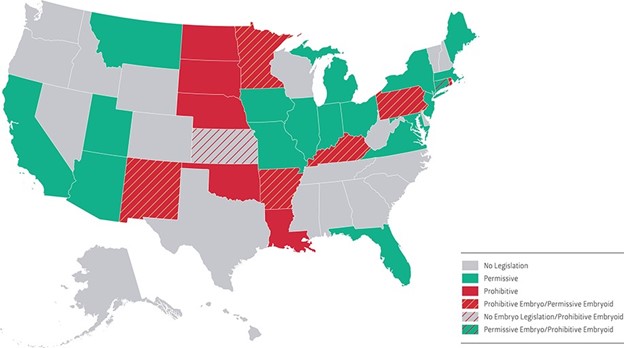In vitro gametogenesis (IVG) has the potential to revolutionize fertility and reproductive technology. The process involves taking cells from the body and turning them into pluripotent stem cells which are then differentiated into egg and sperm cells. This process could potentially allow infertile couples, same sex couples, or even a single individual to create a genetically related offspring.
The ability to use IVG for human reproduction is still many years away, but researchers are excited by the results in studies so far. Researchers have been able to produce primitive egg and sperm cells from induced pluripotent stem cells, but neither are developed enough to create an embryo, although the field is evolving rapidly.1
Since we are at least several years away from seeing clinical trials with embryos created by IVG, now is the perfect time to consider the legal and regulatory implications of this technology. This paper will focus on the regulatory status of IVG.
FEDERAL STATUTES AND REGULATIONS
Research on embryos created through IVG is already underway, but there are no federal laws that govern both public and privately funded research involving embryos.2 Federal laws don’t necessarily prohibit research on embryos created through IVG or otherwise, rather the restrictions are budgetary and if the US government will pay for the research. Under the Dickey-Wicker Amendment (DWA) the federal government is prohibited from funding research that creates, destroys, or seriously injures embryos. This includes the creation of human embryos that are ‘derived by fertilization, parthogenesis, cloning, or any other means from one or more human gametes or human diploid cells’.3
While federal statutes do not prohibit research on the embryos created by IVG, the Food and Drug Administration (FDA) is prohibited from accepting a clinical trial application in which the embryo is intentionally created or modified to include heritable genetic modifications.4 At a meeting of the National Academies of Science, Engineering, and Medicine Dr. Peter Marks, the Director of the Center for Biologics Evaluations and Research at the FDA, confirmed that this prohibition applies to embryos created through IVG.5 This prohibition was introduced in Congress as a rider to the 2016 Appropriations Bill and has been included every year since.6
STATE LAWS
As the federal statutes and regulations are mainly about what can and cannot be funded with federal dollars, where the research can occur will be heavily dependent on state laws. State laws create a complicated patchwork ranging from allowing and funding embryonic research to complete bans.
To further complicate matters, many of the state laws were developed to address other issues, such as abortion, fetal tissue research, reproductive cloning, and human embryonic stem cells (hESC). Some of these laws will overlap with IVG and some of them do not address embryonic research at all.7
There may be other factors that influence the policies and legislation of a given state, including the political party in power, prior morality laws, the policies and attitudes of neighboring states, the strength of the scientific community, and the discussions occurring at the federal level.
States can be grouped into three categories related to embryonic research – states that are permissive, states that are prohibitive, and states that are silent.
Permissive States
Eighteen states permit some or all embryonic research: Arizona, California, Connecticut, Florida, Illinois, Indiana, Iowa, Maine, Maryland, Massachusetts, Michigan, Montana, New Jersey, New York, Ohio, Utah, and Virginia. Of these California, Connecticut, Michigan, Montana, and New York, specifically allow embryonic research. The other states would allow research on embryos due to vague or overly specific legislation around other areas such as hESC research, and research on fetal tissues derived from abortion.
California was the first state to approve legislation allowing embryonic research when Proposition 71 (Prop 71) was enacted in 2004. Not only does Prop 71 allow research on hESC and embryos, it also provides funding for stem cell research and established a new agency, the California Institute of Regenerative Medicine (CIRM), to oversee this research. Shortly after this, other states, including Connecticut and Maryland, started to fund stem cell research. Other states affirm their support of embryonic research by developing regulations that ensure their residents have access to stem cell therapies and cures.
While these states may be supportive of embryonic research, they do have related restrictions. Several states prohibit the creation of embryos solely for research purposes but do allow experimentation on leftover embryos from in vitro fertilization (IVF). Other states will continue to place time frame restrictions ranging from 12 days post fertilization or the development of the primitive streak, to gastrulation, which typically occurs 17 days post fertilization. Still other state laws are silent or define a fetus to start at implantation and therefore would allow in vitro research on the embryos but would prohibit research on fetal tissue obtained from an abortion.
Prohibitive States
Eleven states have legislation banning human embryo research: Arkansas, Kentucky, Louisiana, Minnesota, Nebraska, New Mexico, North Dakota, Oklahoma, Pennsylvania, Rhode Island, and South Dakota. These statutes range from explicitly banning human embryo research, to prohibitions on using public funds or facilities for embryonic research, but do not outright ban it.

Some of the states prohibit fetal research and define fetus to include conception through birth, and therefore all embryonic research would be fetal research. Other statutes are framed as “do no harm” and prohibit the destruction of an embryo, the manipulation of an embryo, or non-therapeutic research or medical treatment. Four states, Arkansas, Kentucky, Nebraska, and Oklahoma, prohibit the use of public funds and facilities to be used for embryonic research, but do not otherwise prohibit it.
Silent States
The remaining 21 states do not have any specific laws regarding embryonic research and rely on federal laws, regulations, and policies. These states are Alabama, Alaska, Colorado, Delaware, Georgia, Hawaii, Idaho, Kansas, Mississippi, Nevada, New Hampshire, North Carolina, Oregon, South Carolina, Tennessee, Texas, Vermont, Washington, West Virginia, Wisconsin, and Wyoming.
CONCLUSION
In vitro gametogenesis has the potential to help untold numbers of people to produce genetically related offspring that would not be able to do so otherwise. Considering the vastly different approaches between the states, it is highly unlikely that there will ever be a consistent approach within the US that facilitates embryonic research. Even in the states that are permissive to embryonic research, there are still limits and many of these statutes are open to interpretation. Consequently, given the current regulatory landscape, there are hurdles to having the U.S. lead in this research endeavor.
One would hope, as the technology improves and it is shown to be safe and effective, particularly if it is done in other countries outside the U.S., there may be more initiatives to create a unified system to foster embryonic research and ultimately allow more clinical trials in the US.
References
- Creating a sperm or egg from any cell? Reproduction revolution on the horizon, Rob Stein, NPR https://www.npr.org/sections/health-shots/2023/05/27/1177191913/sperm-or-egg-in-lab-breakthrough-in-reproduction-designer-babies-ivg
- Can we do that here? An analysis of US federal and state policies guiding human embryo and embryoid research, Kirstin Mattews and Daniel Morali. Journal of Law and the Biosciences, Volume 9, Issue 1, January-June 2022, lsac014, https://doi.org/10.1093/jlb/lsac014
- Consolidated Appropriation Act, H.R 133,116th Cong.(2021). (Dickey-Wicker Amendment).
- H.R. 2029 Consolidated Appropriations Act, 2016 (114th Congress), §749
- Creating a sperm or egg from any cell? Reproduction revolution on the horizon, Rob Stein, NPR https://www.npr.org/sections/health-shots/2023/05/27/1177191913/sperm-or-egg-in-lab-breakthrough-in-reproduction-designer-babies-ivg
- Congress Revives Ban on Altering the DNA of Human Embryos Used for Pregnancies, Andrew Joseph, STAT June 5, 2019 Congress Revives Ban on Altering the DNA of Human Embryos Used for Pregnancies – Scientific American
- Can we do that here? An analysis of US federal and state policies guiding human embryo and embryoid research, Kirstin Mattews and Daniel Morali. Journal of Law and the Biosciences, Volume 9, Issue 1, January-June 2022, lsac014, https://doi.org/10.1093/jlb/lsac014
